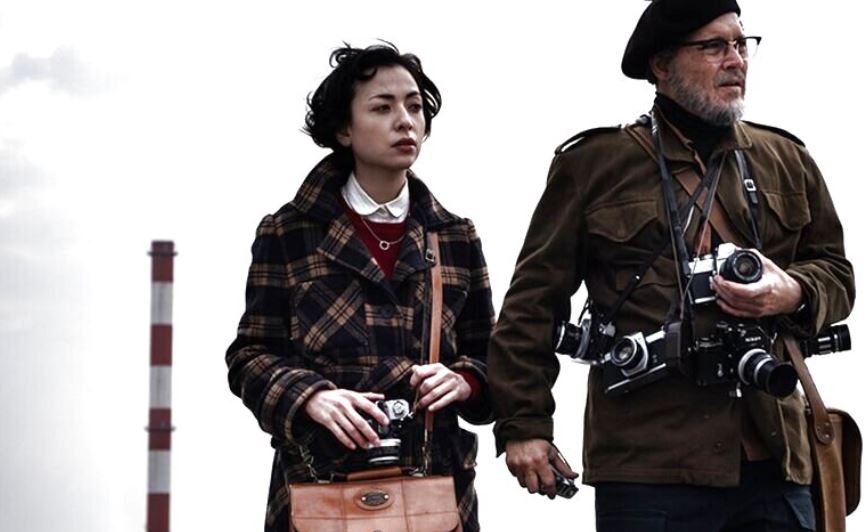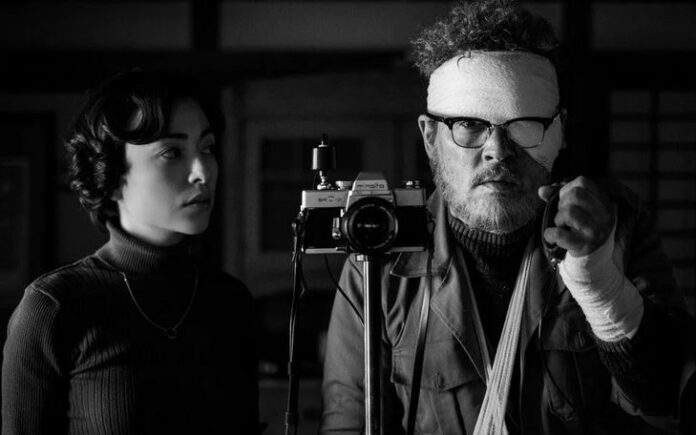By Jana Monji, AsAmNews Arts & Culture Writer
The film Minamata begins with the sound of water. The first person we see is a Japanese woman and she’s singing softly (in Japanese) to a person who we barely get a glimpse of. From there, the film jumps to an old-style photo darkroom where a man uses an enlarger to print before watching the image develop in chemicals. The images are not all pretty.
He’s a photo journalist and even if you don’t remember his name, you should know his most famous image because he was a man who proved that a single image could change world opinion. Or at least, that is the story presented here in the fictionalized account of W. Eugene Smith and his soon-to-be wife’s time in Minamata.
The image is stark, black and white. It is a microcosm–one small village in Japan and expands to a macrocosm, our world and the problem of pollution.
At the center of the film is not the two subjects of that image, but the photographer who is the kind of irascible artist Hollywood loves: W. Eugene “Gene” Smith (Johnny Depp). He drinks. His work space is cluttered. His editor at Life Magazine, Robert Hayes (Bill Nighy), finds him contentious. His unseen kids don’t talk to him and he’s sold all of his photography equipment.
Yet fate comes knocking at his door. Gene had agreed to be part of a Japanese commercial for Fujifilm and the photographer and an interpreter arrive. He’s being paid to endorse the vibrancy of Fuji color film even though he shoots exclusively in black and white.
You might not remember Life magazine. Life magazine was published weekly from 1883 to 1972. In Asian American history, it has some infamy. The Life magazine Pearl Harbor edition advised readers on how to tell the difference between the Chinese (Allies) and the Japanese (Axis). On 22 May 1944, the photo of the week was “Arizona war worker writes her Navy boyfriend a thank-you note for the Japanese skull he sent her.”
On 2 June 1972, the Japanese were given a sympathetic eye in the magazine. The photo essay by Smith was a warning to the world about the problems of pollution, and that warning came from Minamata, Japan.
The neurological disorder caused by mercury poisoning from wastewater emptying into Minamata Bay, Minamata disease, was first discovered in 1956. The mercury was a byproduct of acetaldehyde production at the Chisso chemical company and although the discharge ceased in 1968, the mercury was already in the sea sediment and the fish.
While the film begins in Japan, it quickly jumps back a few years to 1970. Gene is 51. Aileen Sprague is the interpreter for a Fujifilm commercial. Aileen was born and raised in Japan to a Japanese mother and an American father. Her parents moved to the US when she was 11. When Aileen met Gene, she was 20 and on a summer job with the Japanese advertising agency Dentsu.
Gene (Johnny Depp) had agreed to be part of a Japanese commercial for Fujifilm and the photographer is a fan of Gene’s while the interpreter, Aileen (Minami) has her own reasons for taking the assignment: She wants Gene to come to Japan to look at Minamata disease.

In the film, Gene convinces his editor at Life magazine to go with this story. In Minamata, Aileen is often frustrated by Gene’s actions.
The Japanese aren’t helplessly waiting for a savior. The parents of children severely affected have formed a vocal group led by Mitsuo Yamazaki (Hiroyuki Sanada) Gene and Aileen get to know the Matsumura family, mother Mask (Akiko Iwase) and father Tatsuo (Tadanobu Asano). The fight against the Chisso company isn’t easily won and the company isn’t above dirty tactics.
Smith did suffer greatly for the image we finally see recreated here. He was beaten so badly that he had to use a shutter release. The photo has, at the request of the family, been withdrawn from circulation.
There is no pirate-rock star swagger in Depp’s portrayal. His hard-living lifestyle is etched into his face and gives us a ravaged beauty. Depp’s Smith is an already fragile man, haunted by memories of war and possibly suffering from PTSD. His walk is barely above a shuffle.
In general, staging is contrary to the ethical practices of the time and even today would be considered questionable. The film doesn’t address this. (For a fuller discussion on this issue, visit AgeOfTheGeek.org).
As the film ends, the titles tell us that Gene and Aileen were married on 28 August 1971 in Japan. Gene died 15 October 1978 “indirectly as a result of the injuries he received at the factory.” The Minamata essays were the last photos he took.
You might ask, as I did, if this film isn’t a variation of the White savior. The film makes it seem as if Gene and Aileen were the only journalists willing to plunge into the Minata struggles.
That was not the case. Japanese documentarian Noriaki Tsuchimoto (1928-2008), did make a documentary “Minamata: The Victims and their World” (水俣 患者さんとその世界, Minamata: Kanja-san to sono sekai) which premiered in March 1971 according to IMDb. The documentary was screened in Italy in 1972, aired on Swedish television in 1973 and opened in the US in 1974.
Tsuchimoto’s documentary does focus on a severely handicapped young girl, Takako Isayama. The full documentary is currently available on YouTube.
As some other reviewers have suggested that this tale of the Smiths in Minamata would be better told in a documentary, it should be a documentary that included men like Tsuchimoto and showed how the Life magazine spread worked within this greater effort by the Japanese documentarian. Tsuchimoto made several films on the topic.
The film “Minamata” reminds us that the fight for drinkable water isn’t over, even in the US. Think of Flint. The film is “dedicated to the people of Minamata and countless victims of industrial pollution and those who stand with them,” but remember, Tsuchimoto was one of those people who stood by the people of Minamata. The Japanese weren’t saved by a White man, but a White man did make the disaster in Minamata his last comprehensive photo essay.
While the film is flawed, the significance of Minamata, in terms of photojournalism and the fight against pollution, can’t be denied. That makes this film important enough to be recommended. Director Andrew Levitas and writer David Kessler don’t make this a heavy-handed message film and Depp’s portrayal is thoughtful. Depp is 58 and Smith died at 59. For some, it might be hard to think of Depp as old and fragile, but Depp gives us a man you might want to protect, even as he crusades to protect others. Yes, sometimes a photo is worth a thousand words and, in this case, 115 minutes. The lessons learned from Minamata should never be forgotten.
For the full review and a list of all the water-related disasters mentioned in the film, visit AgeOfTheGeek.org.

